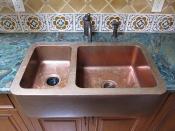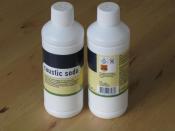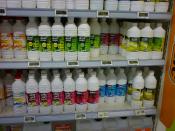The lab was to include a purpose, procedure, data/observations, all reactions and side reactions written out with qualitative data beneath each product and reactant except H20, and a summary.
The purpose of this experiment is to observe the qualitative aspects of a series of reactions involving copper.
Procedure
1.Measure about 1g of solid copper.
2.Place Cu in Erlenmeyer flask and place flask under
fume hood.
3.Add dropwise 15M HNO3 until solid copper is completely reacted.
4.Place flask in water bath.
5.Add 4M NaOH slowly until no more solid forms.
6.Mix contents by slowly swirling flask.
7.Place flask back in water bath, heat to boiling, and stir.
8.Heat until separation of solid and solution.
9.Cool flask and allow contents to settle.
10.Decant liquid from solid.
11.Wash solid with water and decant again.
12. Add 4M HCl until solid disappears, then add 1-2 ml excess.
13.Add 1g of aluminum to flask.
Data/Observations
1.Start with 1g of orange/bronze solid.
2.When HNO3 is added to Cu a dark orange gas is formed.
3.Clear, blue liquid forms when Cu is fully reacted.
4.Solid blue precipitate forms when NaOH is added.
5.When heated, solution turns black.
6.When settled, a dark crystalline solid can be seen on the bottom, and a clear, colorless solution is on top.
7.When HCl is added, a bluish/green solution forms.
8.When solid Al is added, bubbles form and the intensity of the solution's color diminishes.
9.When reaction is complete, orange/bronze solid and clear, colorless solution is visible.
Reactions
1.
Cu + 4HNO3 =
Orange/Bronze Solid Clear, Colorless Liquid
Cu(NO3) 2 + 2NO2 + 2H2O Clear, Blue Liquid Red/Brown Gas
2.
Cu(NO3)2 + NaOH =
Clear, Colorless Liquid
Cu(OH)2 + 2NaNO3
Blue, Solid Precipitate Clear, Colorless Liquid
3.
Excess HNO3 + NaOH = NaNO3 + H2O
4.
Cu(OH)2 + 2HCl =
Black, Crystalline Solid Clear, Colorless Liquid
CuCl2 + 2H2O
Blue/Green Solution
5.
3CuCl2 + 2Al =
Silver Solid
3Cu + 2AlCl Orange/Bronze Solid Clear, Colorless Liquid
6.
Excess 6HCl + 2Al = 3H2 + 2AlCl3
Colorless Gas
Summary
This experiment allows us to observe copper as it goes through a series of reaction. We begin with copper as a pure solid with an orange/bronze color. Then, it becomes part of a clear, blue solution when HNO3 is added. Next, we see it as a solid, blue precipitate with the addition of NaOH. Then, it becomes a black crystalline solid when heated. Next, a blue/green solution in formed when HCl is added. And finally, when solid aluminum is added it reverts back to pure solid copper. If we had enough time for complete reactions to occur, the mass of copper at the end should have been the same as the mass of copper we started with.
Sorry if its a little confusing, copy and paste didn't work out so well. I tried to fix it the best I could.
Corrections
For some reason I can't change this.
In reaction 2, clear,colorless liquid should be under NaOH
In reaction 5, silver solid should be under 2Al
In reaction 6, colorless gas should be under 3H2


